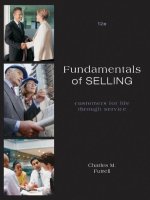Relationship selling through service mkt 173 chap 12
Bạn đang xem bản rút gọn của tài liệu. Xem và tải ngay bản đầy đủ của tài liệu tại đây (1.28 MB, 71 trang )
Closing Begins the Relationship
McGraw-Hill/Irwin
Copyright © 2007 by The McGraw-Hill Companies, Inc. All
Chapter
12
Main Topics
12-2
The Tree of Business Life: Closing
When Should I Pop the Question?
Reading Buying Signals
What Makes a Good Closer?
How Many Times Should You Close?
Closing Under Fire
Difficulties With Closing
Essentials of Closing Sales
Chapter
12
Main Topics
12-3
Prepare Several Closing Techniques
Prepare a Multiple-Close Sequence
Close Based on the Situation
Research Reinforces These Sales Success
Strategies
Keys to Improved Selling
The Business Proposition and the Close
Closing Begins the Relationship
When You Do Not Make the Sale
Chapter
12
The Tree of Business Life: Closing
Guided by The Golden
Rule:
Rule
Look for buying signals.
Be confident in your suggested
True
e
T
vic
Et
h ic
al
r
Se
T
T T
T T TT
T T T T
Builds
Relationships
I
C
order.
Prepare several closes for each
call.
Do not take “No” personally.
Remember that a successful close
begins your relationship.
You now prove your value with
ethical service and your new
relationship.
Closing
Remember to do what’s best for the customer.
Ask yourself, “Should they buy this?” If the
answer is no, tell them you don’t think they really
need the product.
If the buyer still wants to buy, let the Golden Rule
be your guide.
When Should I Pop the Question?
Closing is the process of helping people make a
decision that will benefit them.
There are no magic phrases and techniques to
use in closing a sale.
Close when the prospect is in the _____?___
stage of the mental buying process.
When Should I Pop the Question?
Closing is the process of helping people make a
decision that will benefit them.
There are no magic phrases and techniques to
use in closing a sale.
Close when the prospect is in the conviction
stage of the mental buying process.
Before You Close, What Should Be Done?
Ask a trial close
Why Ask a Trial Close Before You Close?
To determine if the prospect is ready to buy, and
To determine if there are:
Objections
Questions
Let’s Review! When Is It Time to Use a
Trial Close?*
After making a strong selling point in the
presentation
After the presentation but before the close
After answering an objection
Immediately before you move to close the
sale
Let’s Review! What Does the Trial Close
Allow You to Determine?
Whether the prospect likes your product’s
FAB – the strong selling point
Whether you have successfully answered
the objection
Whether any objections remain
Whether the prospect is ready for you to
close the sale
If Objection Arises After the Close*
Move
Move into
into your
your
presentation
presentation
Prospect
Prospect raises
raises
an
an objection
objection
Response
Response to
to
the
the objection
objection
Use
Use aa trial
trial close
close
Close
Close the
the sale
sale
The Parallel Dimensions of Selling*
Discussion Sequence
Discuss Product
Show Feature
Explain Advantage
Lead into Benefit
Let Customer Talk
Present Marketing Plan
Presentation
Discuss Product
Present Marketing Plan
Explain Business Proposition
Suggest Purchase
Availability, Delivery,
Guarantee, Merchandising,
Installation, Maintenance,
Promotion, Training, Warranty
Selling Process
Prospecting Money
Authority
Desire
Buyer’s Mental Steps
Preapproach
Approach
Attention
Interest
Presentation
Desire
Trial Close
Determine Objections
Explain Business Prop
List Price, Shipping Cost,
Discounts, Financing, ROI,
Value Analysis
Meet Objections
Conviction
Trial Close
Suggest Purchase
Product, Quantity, Features,
Delivery, Installation, Price
Close
Follow-up & Service
Action
(Purchase)
Exhibit 12-1: When Is It Time To Close?
When is it time to close?
Close When the Prospect Is Ready
Reading Buying Signals
A buying signal is anything that a prospect says
or does to indicate that he is ready to buy:
Asking questions
Asking another person’s opinion
Relaxing and becoming friendly
Pulling out a purchase order form
Carefully examining merchandise
Exhibit 12-2: Answering a Prospect’s
Buying Signal Question with a Question
Exhibit 12-3: The Moving Selling Process
A positive response to the
trial close indicates a move
toward the close.
A negative response
means return to your
presentation or determine
the prospect’s objections.
What Makes a Good Closer?
Have strong desire to close each sale
Have positive attitude
Know their customers
Tailor presentations to meet each one’s specific
needs
Spend time preparing
Are alert
ABC
Do not stop on first “no”
What Makes a Good Closer?
Ask for the order, and…be quiet (Shhhhhh)!
Must put prospect in position of having to:
Make a decision
Speak first
Respond to the close
Get the order, and…move on
Continuing to talk, may give
information that changes
buyer’s mind
How Many Times Should You Close?
You must be able to use multiple closes.
Three
___________closes
is a minimum.
to five
You will learn how without being pushy
1? 2? 3?
Closing Under Fire
The first “no” from the prospect isn’t necessarily
an absolute refusal to buy.
Closing Under Fire
You must be able to ask a prospect, who may be
in a bad mood or may appear hostile toward you,
to buy
Difficulties With Closing
Closing is the easiest part of the presentation.
Salespeople may fail to close because:
They are not confident in their abilities to close.
They determine that the prospect does not need the quantity or type
of merchandise or that the prospect should not buy.
They may not have worked hard enough to develop a customer
profile and customer benefit plan.
Essentials of Closing Sales
Be sure your prospect understands what you say
Always present a complete story to ensure
understanding
Tailor your close to each prospect (80/20 Rule)
Everything you do and say should consider the
customer’s point of view
Never stop at the first “no”
Learn to recognize buying signals









